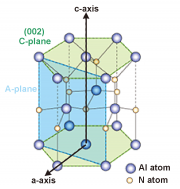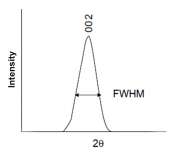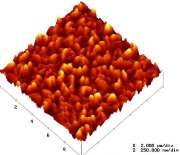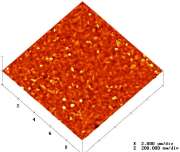Surface Smoothing Processes are Essential for High Performance AlN Piezoelectrics
Aluminium Nitride (AlN) piezoelectrics are the key functional element in the manufacture of Bulk Acoustic Wave (BAW) filters used in mobile communications devices. In addition, some interesting emerging applications such as replacement Si oscillators and energy harvesters may benefit from adopting AlN, since the material provides an excellent balance between device performance and manufacturability.

Fig 1 Schematic diagram of a piezoelectric resonator
A typical BAW device consists of a resonating piezoelectric layer (usually aluminum nitride) sandwiched between two electrodes and suspended over some sort of acoustic reflector such as a film stack or cavity so that it can freely resonate, (see figure 1). The RF properties are directly related to the thickness and material properties (e.g. acoustic density and crystal orientation) of the piezoelectric.
In a RF BAW filter, a high frequency electrical signal is connected across the two electrodes generating an acoustic wave which reflect between the acoustically reflective electrodes.
The main figures of merit for a BAW filter are the electromechanical coupling coefficient Kt2 and the quality factor or Q-value. The coupling coefficient is a measure of the conversion efficiency between electrical to mechanical energy, while the quality factor or Q value is a measure of the selectivity of a resonant circuit described as either the frequency-to-bandwidth ratio, or alternatively as the ratio of energy stored versus lost energy per oscillation cycle.. Higher Q indicates a more selective filter with a steeper characteristic drop-off curve and lower rate of energy loss relative to the stored energy of the resonator. High values for Kt2 and Q factor are necessary for best filter performance.

Fig 2 Wurzite structure of AlN

Fig 3 Schematic rocking curve of diffraction from 002 plane indicating FWHM
Kt2 is related to the crystalline structure of the piezoelectric. For AlN which exhibits a wurtzite structure (See Fig 2), strong c-axis crystal orientation is needed to maximize the coupling coefficient. Crystal orientation can be evaluated from analysis of the X-ray diffraction 002 peak. Fig 3 shows a typical rocking curve.
Full Width Half Max (FWHM) is a measure of the materials crystal orientation, i.e. a narrow/sharp peak means closer to the ideal material. Therefore lower FWHM indicates better alignment of the constituent AlN grains which results in higher Kt2 and better Q factor performance.
In order to get the best AlN texture, a high level of deposition process control is required in the PVD process. However the structure, texture and surface roughness of the underlying layers also have a critical influence on the final AlN film texture. A smooth film surface encourages columnar grains to align perpendicular to the surface resulting in excellent c-axis orientation.
In BAW filter manufacture, substrates are 6” or 8” Si, with a SiOx dielectric grown by conventional CVD or furnace oxidation techniques. Depending on the SiOx deposition method, the initiating SiOx surface can be relatively rough, sometimes as much as 30nm Ra. Too rough an oxide surface will degrade the subsequent piezoelectric layer, so we have developed a process to smooth the SiOx prior to electrode and AlN deposition.
| No Smoothing Etch |
With Smoothing Etch |
 |
 |
|
Al FWHM = 5.0°
Al Roughness = 30 nm
AlN FWHM = 3.0°
|
Al FWHM = 2.4°
Al Roughness = 2.2 nm
AlN FWHM = 1.4°
|
Fig 4 Improvement of AlN FWHM with application of a smoothing etch of the Al electrode surface prior to AlN deposition
Fig 4 shows the effect on AlN texture grown on Al electrodes, deposited on oxide surfaces with different roughnesses. The figure on the right shows that by applying the short in-situ smoothing etch, the orientation of the Al electrode is improved with a corresponding benefit on the piezoelectric layer. The smoothing etch process option is available on the leading Sigma® fxP platform for AlN deposition.
Information on this page contains forward looking information. For more information, click here.